When choosing casters for your equipment, you have two main options: Retractable Leveling Machine Casters and traditional casters. Both types offer unique benefits, and the right choice depends on your specific needs.
Retractable Leveling Machine Casters vs. Traditional Casters: Which One is Right for Your Equipment?
In this article, we’ll explore the key differences between these two types of casters and help you decide which one is best for you.
Understanding the Basics of Retractable Leveling Machine Casters
Casters are essential tools that make it easier to move heavy objects. They come in many forms, but two popular types are retractable leveling casters and traditional casters.
Retractable leveling casters are designed for both mobility and stability, with adjustable leveling pads that can be extended to stabilize equipment on uneven surfaces.
Traditional casters, on the other hand, focus primarily on mobility, offering simple and cost-effective solutions for moving equipment around.
Retractable Leveling Casters: The Modern Solution
Retractable leveling casters are like the Swiss Army knives of casters—they offer multiple functions in one package.(Practical Solutions For A Wide Range Of Industries)
These casters have wheels for mobility and leveling pads that can be extended to provide stability. This dual functionality makes them incredibly versatile and suitable for a wide range of applications.
Key Features:
Material and Construction: Retractable leveling casters are built with durable materials like nylon or polyurethane wheels and steel leveling pads.
These materials ensure that the casters can handle heavy loads and resist wear and tear.
Adjustable Leveling Mechanism:
The standout feature of retractable leveling casters is their adjustable leveling mechanism. This allows users to compensate for uneven surfaces, ensuring that equipment remains stable and level during use.(Leveling Casters)
This is particularly useful in industrial settings, medical facilities, and laboratories where precision and stability are crucial.
Load Capacity:
These casters are designed to handle heavy loads, making them suitable for large machinery, medical equipment, and other heavy-duty applications.
They can support weights ranging from several hundred pounds to several tons.
Versatility:
Retractable leveling casters can easily switch between mobile and stationary modes.
This flexibility is ideal for environments where equipment needs to be moved frequently but must remain stable during use.
Traditional Casters: The Tried-and-True Option
Traditional casters are the simpler, more straightforward option. They consist of a wheel attached to a mounting bracket and are designed primarily for mobility.
While they lack the advanced features of retractable leveling casters, they offer reliable and cost-effective solutions for moving equipment.(Heavy-duty Solution)
Key Features:
Material and Construction: Traditional casters are typically made from durable materials like steel, iron, or high-grade plastic.
The wheels are often constructed from rubber, polyurethane, or nylon, providing a good balance of durability and smooth rolling.
Simplicity and Cost-Effectiveness among Retractable Leveling Machine Casters:
Traditional casters are known for their simplicity. They have fewer moving parts, making them easier to install and maintain.
This simplicity also translates to lower costs, making them a budget-friendly option for many users.
Load Capacity – Retractable Leveling Machine Casters:
Traditional casters are available in a wide range of load capacities, from lightweight models suitable for office furniture to heavy-duty versions capable of supporting large industrial equipment.(Caster Wheels)
However, they generally do not offer the same high-load capacity as retractable leveling casters.
Mobility:
Traditional casters excel in providing basic mobility. They allow equipment to be moved easily from one location to another, making them ideal for applications where frequent movement is required.
Real-World Applications
Retractable Leveling Casters:
Industrial Manufacturing:
These casters are ideal for heavy machinery that needs to be moved around the factory floor but must remain stable during operation.
Healthcare Facilities:
They are commonly used on medical carts, surgical tables, and diagnostic equipment, providing stability during critical procedures.
Laboratories and Clean Rooms:
Retractable leveling casters ensure that equipment remains stable and level, even on uneven surfaces, making them perfect for precision work.(FAQ)
Woodworking and Metalworking Shops:
They offer the flexibility needed to move equipment around while ensuring stability during cutting or machining tasks.
Traditional Casters:
Office Environments:
Traditional casters are often used on desks, chairs, and file cabinets, providing basic mobility without the need for advanced features.
Retail and Commercial Spaces:
They are commonly used on display stands and carts, allowing staff to move items around easily.
Light Industrial Use: For applications where equipment does not need to be moved frequently and the floor is relatively flat, traditional casters offer a cost-effective solution.
User Feedback and Case Studies
Retractable Leveling Casters:
Users often praise retractable leveling casters for their ease of use, durability, and versatility. They report that the adjustable leveling mechanism significantly reduces the risk of equipment tipping or shifting during use.(Project Reference)
In industrial settings, these casters have been shown to improve efficiency and safety by allowing heavy machinery to be moved and secured quickly.
Traditional Casters:
Traditional casters are appreciated for their simplicity and cost-effectiveness. Users in retail and office environments note that these casters provide reliable mobility and require minimal maintenance.
While they lack the advanced features of retractable leveling casters, traditional casters meet the basic need for mobility in many applications.
Making the Right Choice
Choosing the right caster depends on several factors:
Load Capacity:
Retractable leveling casters are better suited for heavy loads, while traditional casters can handle lighter equipment.
Environment:
Retractable leveling casters are ideal for uneven surfaces, whereas traditional casters work well on flat floors.
Frequency of Movemen:
If equipment needs to be moved frequently, traditional casters offer simpler mobility. For occasional movement with a need for stability, retractable leveling casters are preferable.
Budget:
Traditional casters are generally more affordable, making them a cost-effective choice for basic needs.
Conclusion of Retractable Leveling Machine Casters
Retractable leveling casters and traditional casters each have their own strengths. Retractable leveling casters offer advanced features like adjustable leveling and high load capacity, making them suitable for demanding environments.
Traditional casters, on the other hand, provide a simpler, more cost-effective solution for basic mobility needs. By considering your specific requirements, you can choose the right type of caster to meet your equipment’s needs and improve your operational efficiency.










